Is a blockchain project ultimately serving large funds or grassroots crypto natives?
Written by: David, Deep Tide TechFlow
Recently, amidst the surge of Perp DEX, various new projects have emerged like mushrooms after rain, continuously challenging the dominance of Hyperliquid.
Everyone's attention is focused on the innovations of new players, seemingly overlooking how the price of the leading token, $HYPE, will change. The most direct factor related to the price change of the token is the supply of $HYPE.
The factors affecting supply are, first, continuous buybacks, which equate to constantly buying in the existing market to reduce circulation, thereby lowering the water level in the pool; and second, adjustments to the overall supply mechanism, which is akin to turning off the faucet.
Upon closer inspection, the current supply design of $HYPE actually has issues:
The circulating supply is about 339 million tokens, with a market cap of around $15.4 billion; however, the total supply is close to 1 billion tokens, with a fully diluted valuation (FDV) as high as $46 billion.
The nearly threefold difference between market cap (MC) and FDV mainly comes from two parts. One part is 421 million tokens allocated to "Future Emissions and Community Rewards" (FECR), and another 31.26 million tokens held by the Assistance Fund (AF).
The Assistance Fund is an account where Hyperliquid uses protocol revenue to buy back HYPE, purchasing daily but not destroying it, instead holding it. The problem is that investors often perceive the $46 billion FDV as overvalued, even if only a third is actually circulating.
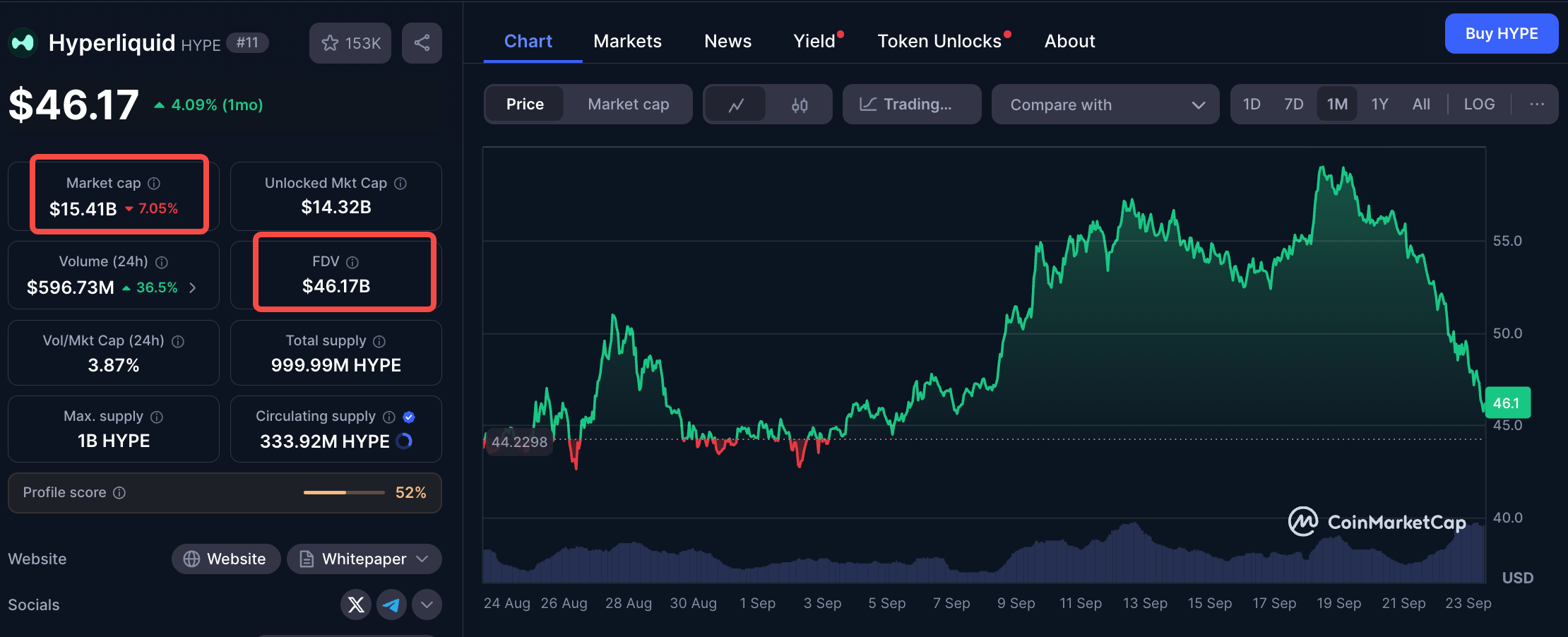
In this context, investment manager Jon Charbonneau (DBA Asset Management, holding a significant position in HYPE) and independent researcher Hasu released an unofficial proposal regarding $HYPE on September 22, which is quite radical; the streamlined version is:
Burn 45% of the current total supply of $HYPE to bring FDV closer to actual circulating value.
After the proposal was issued, it quickly ignited community discussions, and as of the time of writing, the post has garnered 410,000 views.
Why such a strong reaction? If the proposal is adopted, burning 45% of the HYPE supply would mean that the value represented by each HYPE token would nearly double. A lower FDV could also attract previously hesitant investors to enter the market.
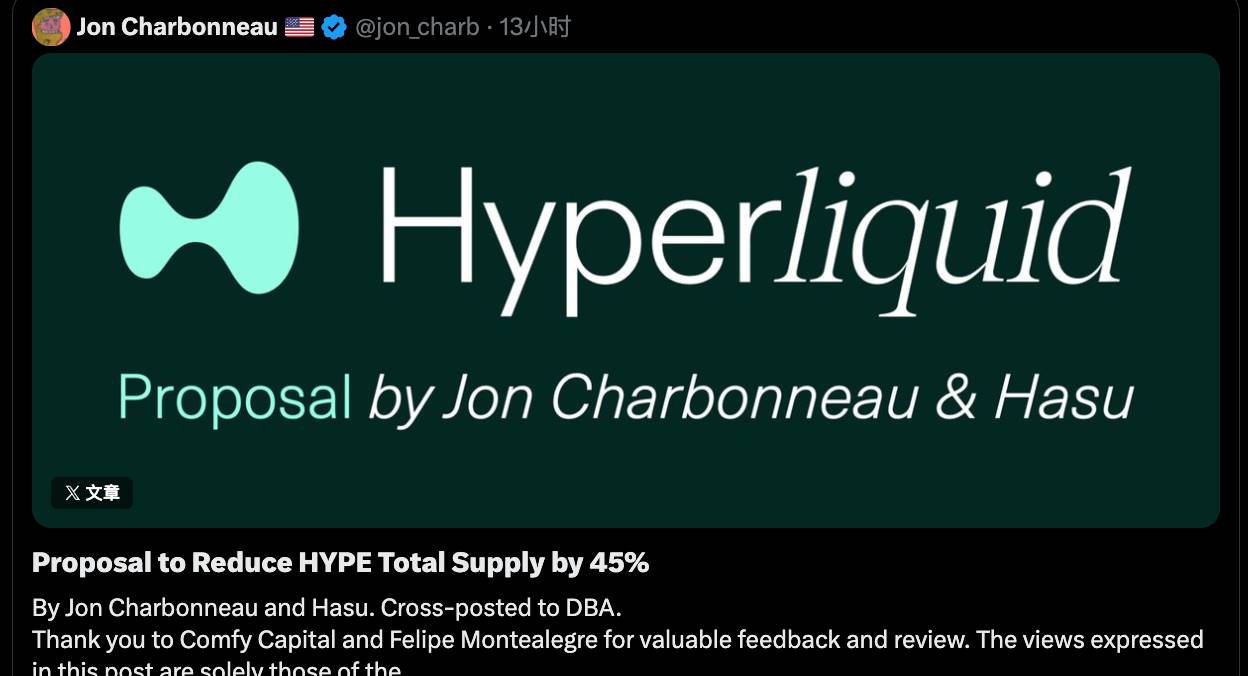
We also quickly summarized the original post's content and organized it as follows.
Reduce FDV, making HYPE appear less expensive
Jon and Hasu's proposal seems simple: burn 45% of the supply, but the actual implementation is quite complex.
To understand this proposal, one must first look at the current supply structure of HYPE. According to the data table provided by Jon, at a price of $49 (the price of HYPE at the time of their proposal), out of a total of 1 billion HYPE tokens, only 337 million are actually circulating, corresponding to a market cap of $16.5 billion.
But where did the remaining 660 million tokens go?
The two largest portions are: 421 million tokens allocated to "Future Emissions and Community Rewards" (FECR), which is essentially a huge reserve pool, but no one knows when or how it will be used; and another 31.26 million tokens held by the Assistance Fund (AF), which buys HYPE daily but does not sell, simply hoarding it.
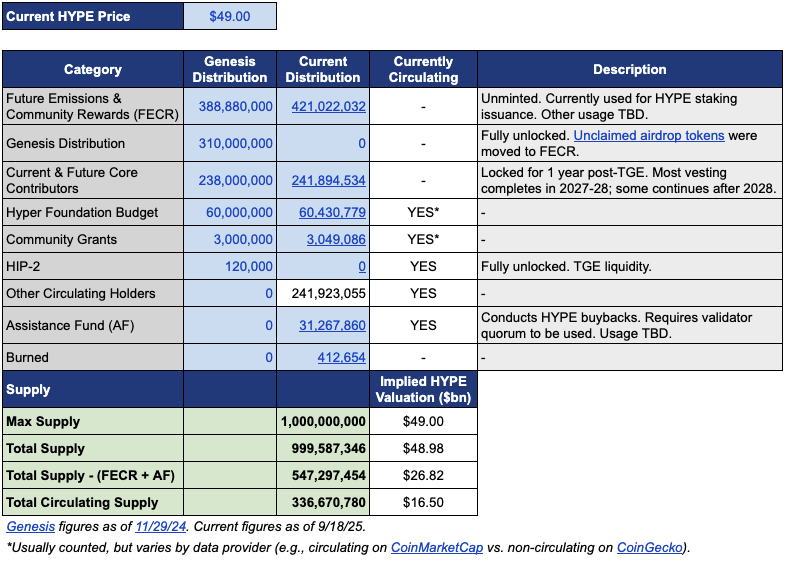
First, let's discuss how to burn. The proposal includes three core actions:
First, revoke the authorization of 421 million tokens from FECR (Future Emissions and Community Rewards). These tokens were originally planned for future staking rewards and community incentives, but there has never been a clear issuance timetable. Jon believes that rather than letting these tokens hang over the market like the sword of Damocles, it is better to revoke the authorization outright. When needed, they can be re-approved for issuance through governance voting.
Second, destroy the 31.26 million HYPE held by the Assistance Fund (AF), and all future HYPE purchased by AF will also be directly destroyed. Currently, AF uses protocol revenue (mainly 99% of trading fees) to buy back HYPE, with an average daily purchase amount of about $1 million. According to Jon's plan, these purchased tokens will no longer be held but will be immediately burned.
Third, remove the supply cap of 1 billion tokens. This sounds counterintuitive; if the goal is to reduce supply, why remove the cap?
Jon explains that the fixed cap is a remnant of Bitcoin's 21 million model, which has no practical significance for most projects. After removing the cap, if new tokens need to be issued in the future (for example, for staking rewards), the specific quantity can be decided through governance rather than being allocated from a reserved pool.
The comparison table below clearly shows the changes before and after the proposal: the left side shows the current situation, while the right side shows the situation after the proposal.

Why be so radical? The core reason given by Jon and Hasu is that the token supply design of HYPE is an accounting issue, not an economic issue.
The problem lies in how major data platforms like CoinmarketCap calculate these figures.
Burned tokens, FECR reserves, and AF holdings are treated differently by each platform when calculating FDV, total supply, and circulating supply. For instance, CoinMarketCap always uses the maximum supply of 1 billion to calculate FDV, even if tokens have been burned, it does not adjust.
The result is that no matter how much HYPE is repurchased or burned, the displayed FDV does not decrease.
It can be seen that the biggest change in the proposal is that the 421 million from FECR and the 31 million from AF will disappear, while the hard cap of 1 billion will also be removed, replaced by governance-based issuance as needed.
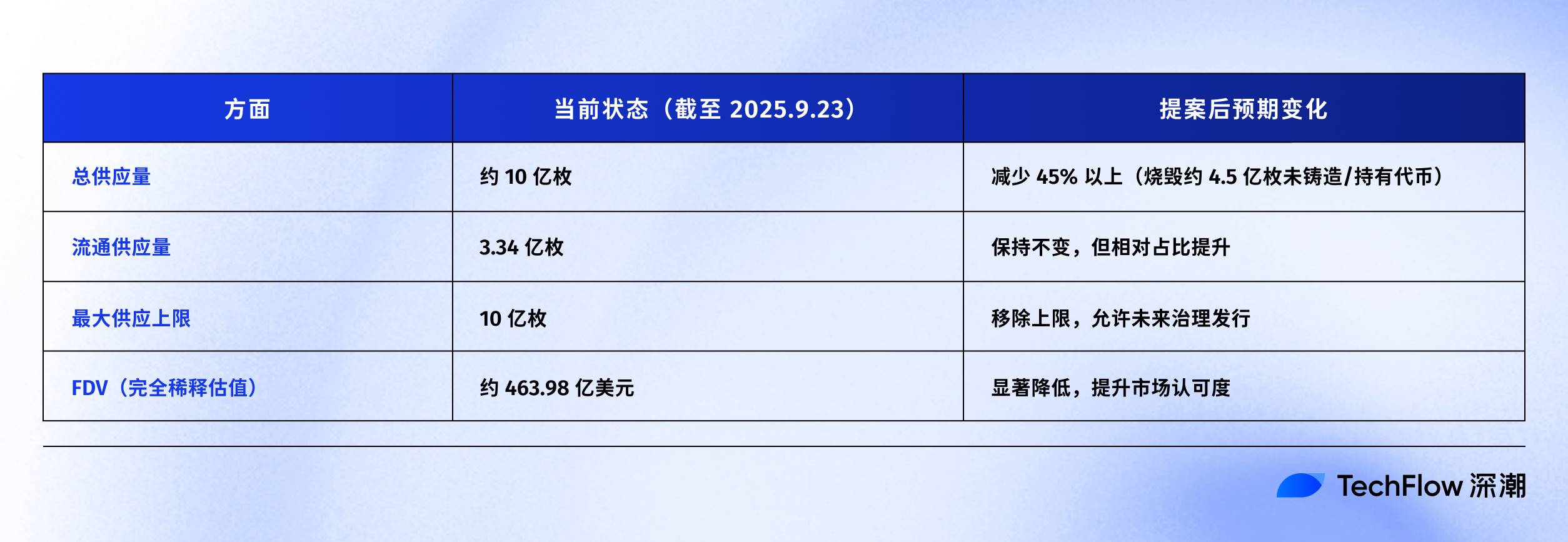
Jon wrote in the proposal: “Many investors, including some of the largest and most mature funds, only look at the surface FDV numbers.” An FDV of $46 billion makes HYPE appear more expensive than Ethereum; who would dare to buy?
However, most proposals have a bias based on self-interest. Jon clearly states that the DBA fund he manages holds a "material position" in HYPE, and he personally holds it as well; if there is a vote, they would all vote in favor.
The proposal emphasizes that these changes will not affect the relative shares of existing holders, will not impact Hyperliquid's ability to fund projects, and will not change the decision-making mechanism. In Jon's words,
“This just makes the ledger more honest.”
When "allocated to the community" becomes a tacit rule
But will the community buy into this proposal? The comments section of the original post has already exploded.
Among them, Dragonfly Capital partner Haseeb Qureshi's comment places this proposal within a larger industry phenomenon:
“There are some 'sacred cows' in the crypto industry that just won't die; it's time to slaughter them.”
He refers to a tacit rule in the entire crypto industry: after generating tokens, project teams always reserve a so-called 40-50% of the token share for the "community." This sounds very decentralized and Web3, but in reality, it is a form of performance art.
In 2021, during the peak of the bull market, every project was competing to be more "decentralized." Thus, token economics stated that 50%, 60%, or even 70% would be allocated to the community, with larger numbers being more politically correct.
But how exactly are these tokens used? No one can clearly explain.
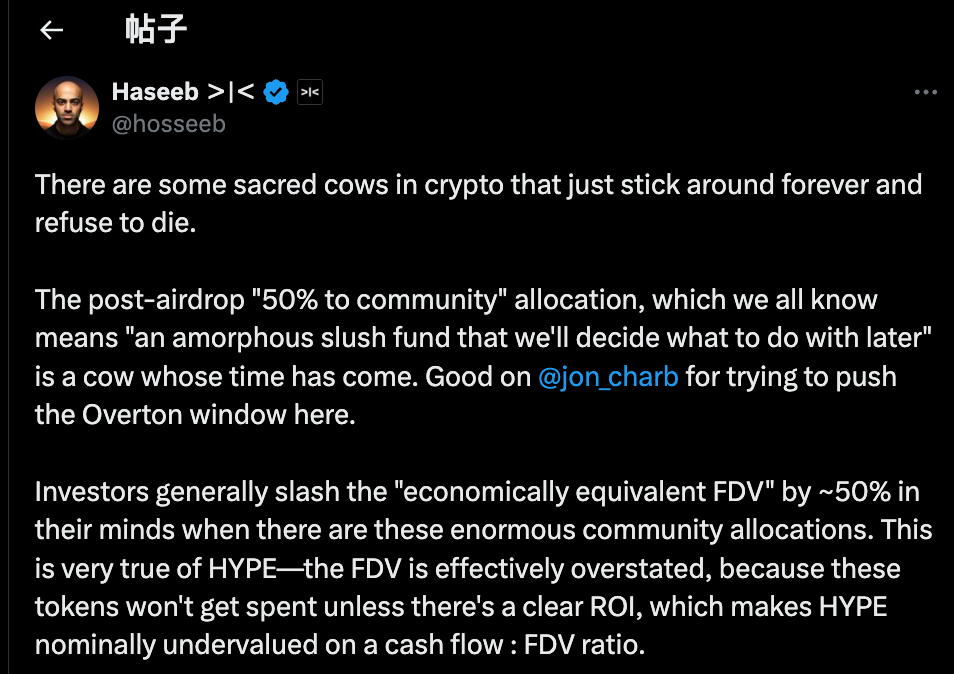
From a more malicious perspective, some project teams, regarding the tokens allocated to the community, have a more realistic situation where they use them whenever they want and however they want, under the guise of "for the community."
The problem is, the market is not foolish.
Haseeb also revealed an open secret: professional investors automatically discount these "community reserves" by half when evaluating projects.
A project with an FDV of $50 billion but with 50% "community allocation" is seen by them as having an actual valuation of only $25 billion. Unless there is a clear ROI, these tokens are just empty promises.
This is precisely the issue HYPE faces. Over 40% of HYPE's $49 billion FDV is from the reserves of "Future Emissions and Community Rewards." Investors see this number and are deterred.
It's not that HYPE is bad, but because the numbers on paper are too inflated. Haseeb believes that Jon's proposal is a driving force, gradually turning radical ideas that could not be publicly discussed into acceptable mainstream views; we need to question the crypto industry's practice of allocating tokens to "community reserves."
In summary, the supporters' viewpoint is straightforward:
If tokens are to be used, governance should be followed, clearly stating why they are issued, how much, and what the expected returns are. Transparency and accountability, rather than a black box.
At the same time, due to the radical nature of this post, there are also some opposing voices in the comments section. We summarized them into three main parts:
First, some HYPE must be kept as a risk reserve.
From a risk management perspective, some believe that the 31.26 million HYPE in the Assistance Fund (AF) is not just inventory but also emergency funds. What if there are regulatory fines or hacker attacks that require compensation? Burning all reserves would mean losing a buffer in times of crisis.
Second, HYPE already has a complete destruction mechanism in place.
Hyperliquid already has three natural destruction mechanisms: spot trading fee destruction, HyperEVM gas fee destruction, and token auction fee destruction.
These mechanisms automatically adjust supply based on platform usage; why intervene artificially? Destruction based on usage is healthier than a one-time burn.
Third, large-scale destruction is detrimental to incentives.
Future emissions are Hyperliquid's most important growth tool, used to incentivize users and reward contributors. Burning them would be like cutting off one's own limbs. Moreover, large stakers would be locked in. If there are no new token rewards, who would still be willing to stake?
Who do the tokens serve?
On the surface, this is a technical discussion about whether to burn tokens or not. But upon closer analysis of the positions of various parties, it becomes clear that the differences are fundamentally about self-interest.
The viewpoint represented by Jon and Haseeb is clear: institutional investors are the main source of incremental funds.
These funds manage billions of dollars, and their purchases can truly drive prices. But the problem is, they hesitate to enter the market when they see a $49 billion FDV. Therefore, the number needs to be corrected to make HYPE more attractive to institutions.
The community's perspective is completely different. In their eyes, it is the retail traders who open and close positions on the platform every day that form the foundation. Hyperliquid's current success relies not on VC money, but on the support of 94,000 airdrop users. Changing the economic model to cater to institutions is putting the cart before the horse.
This divergence is not a new occurrence.
Looking back at DeFi history, almost every successful project has faced a similar crossroads. When Uniswap launched its token, the community and investors argued fiercely over control of the treasury.
The core issue is essentially the same each time: is a blockchain project ultimately serving large funds, or is it serving grassroots crypto natives?
This proposal seems to cater to the former, as "many of the largest and most mature funds only look at FDV." The implication is clear: to attract this big money, the game must be played by their rules.
The proposer, Jon, is himself an institutional investor, and his DBA fund holds a significant amount of HYPE. If the proposal passes, the biggest beneficiaries will be large holders like him. A reduction in supply could lead to an increase in token price, thereby raising the value of their holdings.
Combined with the fact that just a few days ago, Arthur Hayes sold $800,000 worth of HYPE jokingly to buy a Ferrari, one can sense a subtle timing. The earliest supporters are cashing out, while now there is a proposal to burn tokens to drive up prices—who exactly is being lifted here?
As of the time of writing, Hyperliquid's official stance has not yet been stated. But regardless of the final decision, this debate has exposed a truth that many are reluctant to face:
When it comes to profit, we may have never truly cared about decentralization; we have merely been pretending.
免责声明:本文章仅代表作者个人观点,不代表本平台的立场和观点。本文章仅供信息分享,不构成对任何人的任何投资建议。用户与作者之间的任何争议,与本平台无关。如网页中刊载的文章或图片涉及侵权,请提供相关的权利证明和身份证明发送邮件到support@aicoin.com,本平台相关工作人员将会进行核查。




